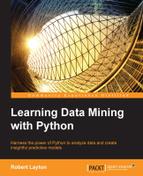In this chapter, we looked at graphs from social networks and how to do cluster analysis on them. We also looked at saving and loading models from scikit-learn by using the classification model we created in Chapter 6, Social Media Insight Using Naive Bayes.
We created a graph of friends from a social network, in this case Twitter. We then examined how similar two users were, based on their friends. Users with more friends in common were considered more similar, although we normalize this by considering the overall number of friends they have. This is a commonly used way to infer knowledge (such as age or general topic of discussion) based on similar users. We can use this logic for recommending users to others—if they follow user X and user Y is similar to user X, they will probably like user Y. This is, in many ways, similar to our transaction-led similarity of previous chapters.
The aim of this analysis was to recommend users, and our use of cluster analysis allowed us to find clusters of similar users. To do this, we found connected components on a weighted graph we created based on this similarity metric. We used the NetworkX package for creating graphs, using our graphs, and finding these connected components.
We then used the Silhouette Coefficient, which is a metric that evaluates how good a clustering solution is. Higher scores indicate a better clustering, according to the concepts of intra-cluster and inter-cluster distance. SciPy's optimize module was used to find the solution that maximises this value.
In this chapter, we compared a few opposites too. Similarity is a measure between two objects, where higher values indicate more similarity between those objects. In contrast, distance is a measure where lower values indicate more similarity. Another contrast we saw was a loss function, where lower scores are considered better (that is, we lost less). Its opposite is the score function, where higher scores are considered better.
In the next chapter, we will see how to extract features from another new type of data: images. We will discuss how to use neural networks to identify numbers in images and develop a program to automatically beat CAPTCHA images.
